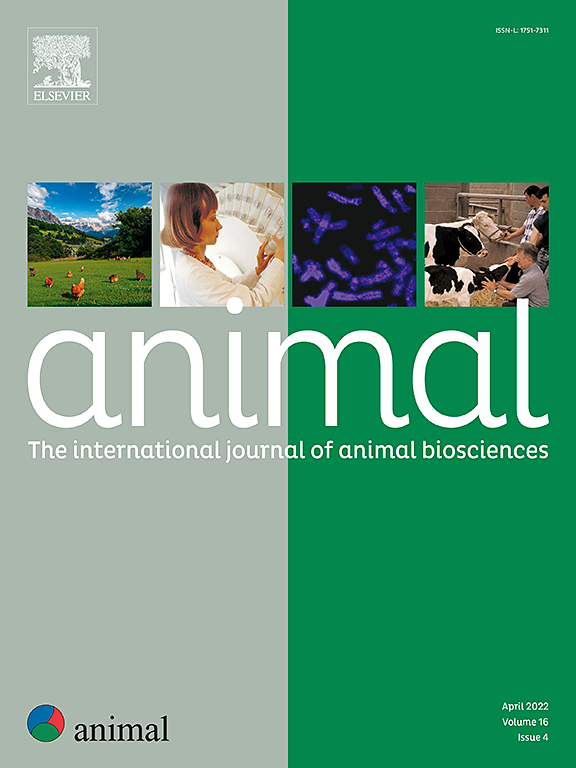A type 2 immune circuit and arachidonic acid metabolism role in anti-nematode infection: evidence from transcriptome and targeted metabolome data in goat
IF 4
2区 农林科学
Q1 AGRICULTURE, DAIRY & ANIMAL SCIENCE
引用次数: 0
Abstract
The gastrointestinal nematode infection poses a covert threat to both humans and domestic animals worldwide, eliciting a type 2 immune response within the small intestine. Intestinal tuft cells detect the nematode and activated group 2 innate lymphoid cells. Tuft cell−derived leukotrienes (one of the metabolites of arachidonic acid) were found to drive rapid anti-helminth immunity, but it is still poorly understood whether the tuft cell−mediated type 2 immune circuit and arachidonic acid metabolism modulate anti-parasitic immunity in the gastric epithelium. This study was designed to evaluate the immunological responses of goats inoculated with or without H. contortus. Results showed that H. contortus infection induced a systemic type 2 immune response, characterised by lymphocyte proliferation and greater eosinophils both in peripheral blood and abomasal mucosa, as well as increased type 2 cytokines IL-4, IL-5, and IL-13. Infection of H. contortus altered the transcriptome of the abomasum epithelium, especially tuft cell−mediated circuit-key genes. The infection also influenced the abomasal microbiota, arachidonic acid metabolism and related lipid metabolites, accompanying with great increases in the secretion of leukotrienes and prostaglandins. These findings demonstrate the role of tuft cells mediated circuit in sensing H. contortus infection and immune activation, reveal the candidate function of arachidonic acid involved in anti-helminth immunity, and suggest novel strategies for the control of parasitic diseases in livestock and humans.
2型免疫回路和花生四烯酸代谢在抗线虫感染中的作用:山羊转录组和靶向代谢组数据提供的证据
胃肠道线虫感染对全世界的人类和家畜都构成了隐性威胁,它会在小肠内引起 2 型免疫反应。肠绒毛细胞能检测到线虫,并激活第 2 组先天性淋巴细胞。研究发现,簇细胞衍生的白三烯(花生四烯酸的代谢产物之一)可驱动快速的抗线虫免疫,但人们对簇细胞介导的 2 型免疫回路和花生四烯酸代谢是否调节胃上皮的抗寄生虫免疫仍知之甚少。本研究旨在评估接种或不接种轮虫的山羊的免疫反应。结果表明,感染了传染性软疣梭菌会诱发全身性 2 型免疫反应,表现为淋巴细胞增殖、外周血和腹腔粘膜中嗜酸性粒细胞增多,以及 2 型细胞因子 IL-4、IL-5 和 IL-13 增高。感染霍乱弧菌改变了腹腔上皮细胞的转录组,尤其是簇细胞介导的电路关键基因。感染还影响了腹腔微生物群、花生四烯酸代谢和相关脂质代谢产物,并伴随着白三烯和前列腺素分泌的大量增加。这些研究结果证明了簇细胞介导的回路在感知霍乱弧菌感染和免疫激活中的作用,揭示了花生四烯酸参与抗蠕虫免疫的候选功能,并为控制家畜和人类寄生虫病提出了新的策略。
本文章由计算机程序翻译,如有差异,请以英文原文为准。
求助全文
约1分钟内获得全文
求助全文
来源期刊

Animal
农林科学-奶制品与动物科学
CiteScore
7.50
自引率
2.80%
发文量
246
审稿时长
3 months
期刊介绍:
Editorial board
animal attracts the best research in animal biology and animal systems from across the spectrum of the agricultural, biomedical, and environmental sciences. It is the central element in an exciting collaboration between the British Society of Animal Science (BSAS), Institut National de la Recherche Agronomique (INRA) and the European Federation of Animal Science (EAAP) and represents a merging of three scientific journals: Animal Science; Animal Research; Reproduction, Nutrition, Development. animal publishes original cutting-edge research, ''hot'' topics and horizon-scanning reviews on animal-related aspects of the life sciences at the molecular, cellular, organ, whole animal and production system levels. The main subject areas include: breeding and genetics; nutrition; physiology and functional biology of systems; behaviour, health and welfare; farming systems, environmental impact and climate change; product quality, human health and well-being. Animal models and papers dealing with the integration of research between these topics and their impact on the environment and people are particularly welcome.
 求助内容:
求助内容: 应助结果提醒方式:
应助结果提醒方式:


